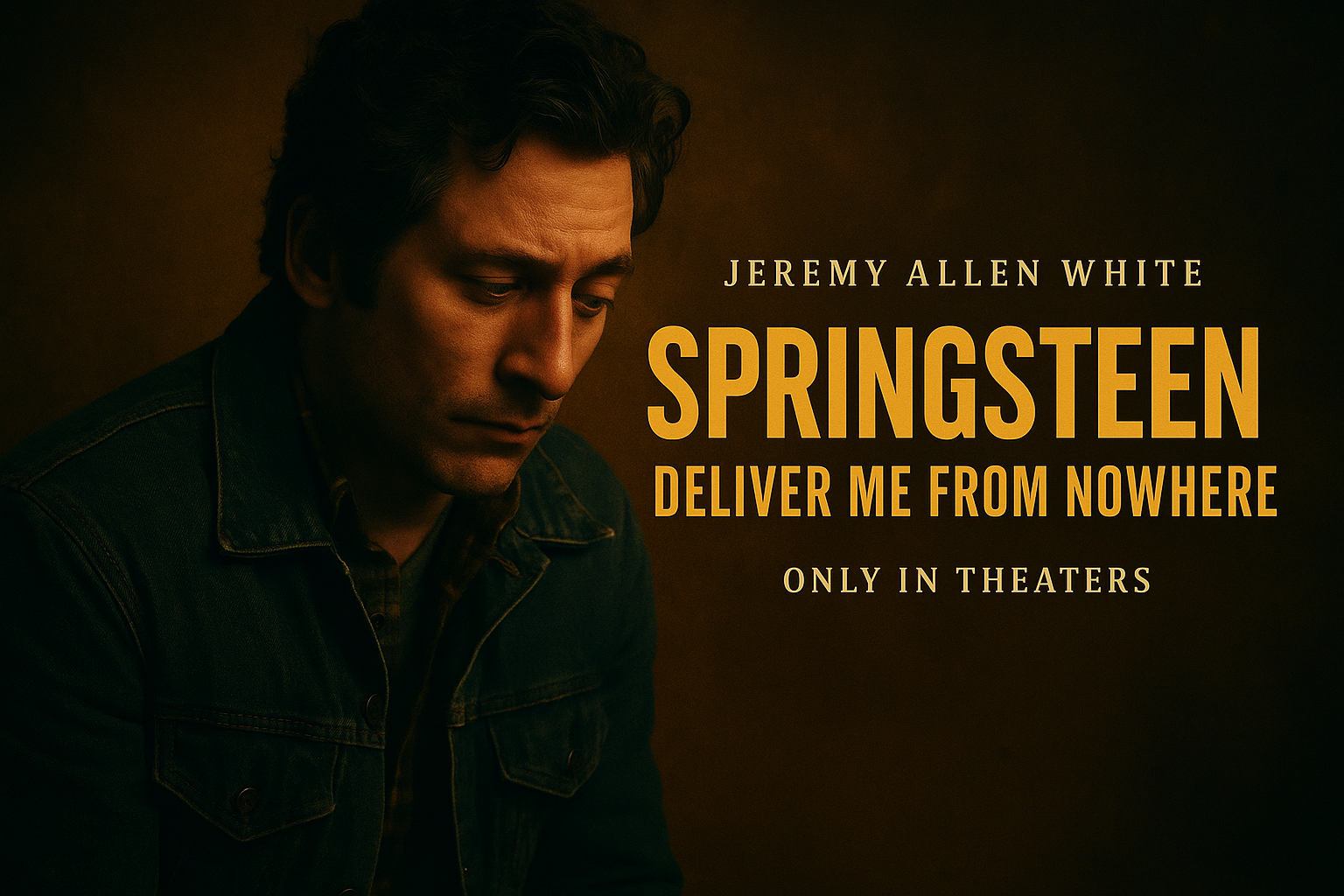
Scott Cooper’s intimate biographical drama turns away from stadium fireworks and points the camera at a solitary artist wrestling with doubt, family, and the creative choices that shaped the stark masterpiece known as Nebraska. This review explores the film’s performances, craft, themes, and where it soars — and stumbles.
Overview
Springsteen: Deliver Me From Nowhere is less a cradle-to-arena mythmaking biopic and more a wintered-in character study. It narrows its timeline to the early 1980s, locating Bruce Springsteen at a creative crossroads after the victories of the previous decade. With the world expecting a brighter, louder sequel to success, he instead turns inward, recording rough demos in New Jersey on a simple four-track. What emerges — and what the film frames as its ethical and emotional center — is the austere, morally haunted song cycle that became Nebraska.
Rather than reenact greatest-hits iconography, the film favors silences, empty rooms, long drives, and thorned conversations. It’s a study of process, pressure, and the cost of making art that refuses the market’s demand for gloss. The approach will be catnip for viewers who love actor-driven dramas about creativity; others craving triumphant concert crescendos may find its restraint severe. That rigor, for better and sometimes worse, is the point.
Key Credits (Selected)
| Director / Writer | Scott Cooper |
| Based on | The period surrounding the writing and recording of Nebraska |
| Lead Cast | Jeremy Allen White (Bruce Springsteen), Jeremy Strong (Jon Landau), Stephen Graham (Douglas “Dutch” Springsteen), Odessa Young (Faye) |
| Photography / Music | Muted, naturalistic cinematography with spare, textural score emphasizing tape hiss, breath, and room tone |
What The Film Is Really About
At first glance this is a movie about the making of an album. Under the hood it’s about authenticity — the terrifying kind that has nothing to hide behind. Springsteen’s character is drawn as a man between obligations: to a hungry public, to a watchful industry, to the band who helped carry him there, and to a private, stubborn conscience that refuses translation into an easy radio anthem. The screenplay dramatizes that tangle through a handful of charged relationships and a mood of purposeful austerity.
The film’s central polarity is between two Americans: the son who writes about blue-collar ghosts and the father who, in the movie’s telling, personifies those ghosts — pride and shame fused together. Their scenes are written with the tension of things unsaid: cramped kitchens, cigarette smoke curling under low light, silence weaponized into a kind of dare. A second, gentler polarity pits art against commerce. Jon Landau isn’t framed as a villain; he’s a realist who wants the artist he believes in to reach as many people as possible. The drama works because the film respects both sides of that conversation even as it chooses the lonelier road.
Performance: Jeremy Allen White Finds The Quiet Frequencies
Jeremy Allen White gives a performance pitched in half-tones. He resists the obvious tics of mimicry and instead plays a man listening — to himself, to the hum of the house, to a story that wants to be told without adornment. In long takes his posture carries the weight: shoulders slightly forward, eyes a little down and a little far away. When he sings, the camera keeps its distance, emphasizing intimacy over spectacle. It’s the kind of portrayal that can seem muted on the surface until you realize how much it trusts the audience to lean in.
As the manager and sometime conscience, Jeremy Strong is nuanced and unshowy. His Landau knows how the machine works and, crucially, why it matters — not as an enemy of art but as the bridge to listeners who need it. Their negotiations feel like the film’s finest scenes: two men trying to protect the same thing from different angles. Stephen Graham’s father is a blunt instrument with a cracked interior; you feel the bruise of history in every clipped response. Odessa Young, meanwhile, supplies an alternate current — warmth, curiosity, the small domestic gestures that keep a person from vanishing into work.
Direction & Craft: Austerity As Aesthetic
Scott Cooper builds the movie around the discipline of “less.” Rooms are under-lit. Streets are empty. The palette leans toward browns, winter greens, and grayed blues. Even the sound design is lean — an unobtrusive mix where you hear the chair creak, the hum of tape, the thrum of night. The cinematography favors still frames and a patient lens that watches rather than hurries. These choices are not just style; they’re a thesis, mirroring the monochrome morality tales of the songs themselves.
The gamble is that such rigor can risk monotony. There are stretches where the movie’s commitment to restraint slides toward stasis. Some sequences rehearse familiar biopic grammar (creative block; father-son blow-ups; the “will he compromise” debate). When the film actively pushes beyond convention — for example, by letting whole scenes play with only ambient sound — it feels alive. When it falls back on tidy beats, the magic thins.
Music On Screen: When Silence Is The Hook
Viewers expecting a jukebox of anthems will instead encounter a study of how songs are born. The film is careful with recognizability; it grants the music gravity by not oversupplying it. A recurring device lets the camera linger on a lyric forming, then cuts away just before the line resolves. That denial keeps the focus on process and interiority: the chord changes are less interesting than the human changes required to earn them.
Even so, when the movie finally allows a song to bloom, the payoff lands precisely because of the preceding restraint. The contrast — between wide-open stadium myth and the micro-drama of a man and a machine — clarifies what this chapter in Springsteen’s life meant: a deliberate refusal of volume as proof of truth.
Scenes That Stay
- The Drive: Night highway, dashboard glow, a cassette hiss riding the wind. No dialogue — just the American nowhere the title promises to deliver him from. It’s both literal road and moral landscape.
- The Kitchen Standoff: Father and son circling a subject neither will name. Two close-ups, a clock ticking offscreen, and a single line that lands like a slammed drawer. The film’s thesis in miniature.
- The Recording Room: A low ceiling, a cheap mic, and a lyric that arrives as if overheard. It captures the sacred ordinariness of making something that matters.
What Works
- An anti-biopic spine: Narrow focus and emotional specificity protect the movie from the episodic cradle-to-legend clichés that hobble many music dramas.
- Performance cohesion: White’s inward energy meets Strong’s pragmatic warmth and Graham’s hard-edged vulnerability; the ensemble feels lived-in and believable.
- Form mirrors content: Minimalist craft decisions align with the album at the film’s heart, turning aesthetic choice into meaning.
- Respect for ambiguity: The movie doesn’t solve its protagonist; it invites us to sit with him.
Where It Stumbles
- Rhythmic sameness: Rigor occasionally calcifies into repetition, with multiple scenes doing similar emotional work.
- Conventional detours: A few familiar biopic beats dilute the more radical quiet the film otherwise embraces.
- Audience expectation gap: Viewers hunting for a rousing, career-spanning celebration may misread the film’s austerity as thinness rather than intent.
Themes Under The Skin
Authenticity vs. Acceptance. The movie positions art as a promise you make to yourself first. The cost is loneliness; the reward is voice.
Inheriting Work. The father-son thread isn’t simply antagonism; it’s about the burden of the stories we carry from our families and the working-class dignity — and damage — they can imprint.
Silence As Story. What is left unplayed and unsaid becomes the narrative engine. The result is a film that trusts quiet to communicate the contradictions of a public figure protecting a private self.
Editing, Pacing, and the Question of Access
The edit is unflashy by design, favoring dissolves and hard cuts that keep us near the character’s attention rather than impose an editorial point. A handful of montage passages mark time’s passing without resorting to needle-drop shorthand. The pacing choice — steady, measured — asks the audience to adapt to the film’s breathing. Whether that invitation reads as immersive or inert will depend on temperament. For this reviewer, the cumulative effect is absorbing with brief sags in the middle stretch.
Industry Context: A Different Kind of Music Movie
In an era crowded with glossy legends-on-parade packages, Springsteen: Deliver Me From Nowhere takes the risky route of narrowing scope and lowering volume. It belongs to the small shelf of music dramas that treat composition like archaeology, excavating why a record had to sound the way it does. The gamble pays off because the film understands the tension between myth and man — and chooses the man.
For Fans — And Newcomers
If you come to the film already fluent in Springsteen’s catalog, you’ll catch echoes in gestures and glances: the way a riff is tapped out on a knee, the stubborn revision of a single phrase. If you arrive a newcomer, the movie still plays as a story about any artist trying to honor a difficult truth when easier truths would sell faster. Either way, the emotional grammar is clear: decency is hard, honesty is harder, and both begin in the dark.
Final Verdict
Rating: ★★★½ / ★★★★★
A quiet, carefully crafted portrait anchored by a tremor-sensitive lead performance. Not every scene justifies its own hush, and a handful of familiar biopic moves flatten what is otherwise a bracingly austere film. But when Springsteen: Deliver Me From Nowhere aligns its form with its subject — when it trusts the power of an unadorned line delivered in a small room — it becomes moving, memorable cinema about the courage it takes to choose the smaller, truer song.
Should You Watch It?
- Absolutely yes if you’re drawn to actor-driven dramas about creativity, thorny family histories, and the moral stakes of honest work.
- Maybe if you expect a celebratory concert film; this isn’t that — it’s the proof behind the songs.
Trailer & Clips (Provided)
Trailer Courtesy Of Twentieth Century Studios
Film Clip Courtesy of Twentieth Century Studios
Movieversalfilm — Your AI-powered entertainment magazine for the UK & US.
